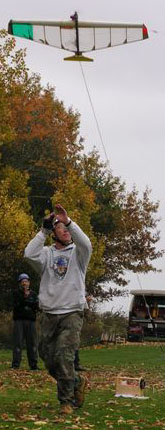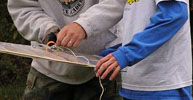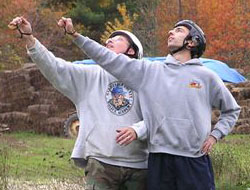After a long, exciting, and hopefully very enjoyable 6 months, the first season of F2D combat in New England has
 finally drawn to a close. This does not necessarily mean, however, that it is time to pack everything away in
mothballs to wait in a corner of the basement until spring arrives. It is not uncommon to have a nice sunny day
now and again during the winter months, and if there’s time, it would be great to take advantage of such days by
putting in a few flights to keep tuned up as best as possible for the start of next season. After experiencing
my first “off-season” last winter, I found out how easy it is to take a few steps backwards over such a period
without any practice.
finally drawn to a close. This does not necessarily mean, however, that it is time to pack everything away in
mothballs to wait in a corner of the basement until spring arrives. It is not uncommon to have a nice sunny day
now and again during the winter months, and if there’s time, it would be great to take advantage of such days by
putting in a few flights to keep tuned up as best as possible for the start of next season. After experiencing
my first “off-season” last winter, I found out how easy it is to take a few steps backwards over such a period
without any practice.
Regardless of whether or not you expect to do any more flying between now and April, the end of the season is a good time to go through your
equipment to inspect it for any problems and perform routine preventative maintenance operations. If any of your engines have been in the
ground and you haven’t had the chance to open them up for a thorough cleaning, now is the time to do it. Additionally, the air was quite damp
during the final contest of the season, which undoubtedly left water residue in any engine that was exposed to the elements that day. To
prevent rusting, it would be good to try to just run each engine briefly (30 or 45 seconds should be plenty) outdoors on a nice dry day, to
replace whatever water residue might be in there with nice film lubricating/preserving oil. Other things to check for are bad bearings, which
can be spotted by lightly turning the crank back and forth and feeling for a “tick,” and sand-blasting of the head, which is a sign of excessive
compression (see article on head clearances in the Resources section of the F2D News webpage). Once all this is complete, it’s a good final
measure to put some additional oil (e.g. 3-in-1 oil, Marvel Mystery Oil) in the front bearing, down the venturi, and into the cylinder, to
prevent rusting as the engine sits in wait for its next use.
On Sunday October 24th, the final F2D event of the season took place in Middleboro, MA. In addition to the now-regular New England F2D crew,
2004 US F2D Team member Ron Colombo was on hand for this contest. To give everyone as much flying time as possible, we decided to fly triple
elimination rather than double. Things went pretty smoothly, and we finished with plenty of daylight to spare. For a detailed report on the
contest, see Neil’s contest report on the
NECN
webpage.
 The weather on Sunday was a little chilly and a little damp, but overall quite pleasant for this time of year. On Saturday, Ron and I were at
the Middleboro site for some test flying, and the weather was much colder and windier. I was test flying with an old set of lines, and had one
break all by itself. I mention this just as a reminder for everyone to keep a close eye on the condition of his/her lines to avoid needless
mishaps such as this.
The weather on Sunday was a little chilly and a little damp, but overall quite pleasant for this time of year. On Saturday, Ron and I were at
the Middleboro site for some test flying, and the weather was much colder and windier. I was test flying with an old set of lines, and had one
break all by itself. I mention this just as a reminder for everyone to keep a close eye on the condition of his/her lines to avoid needless
mishaps such as this.
More interestingly, during that training session I encountered the first major problem with one of the Cyclon PC6 engines that I have been
testing over the course of this season. When I tightened the propeller on one of the engines in preparation for a test flight, the engine
suddenly got tight and would not turn over. After several minutes of fiddling around trying to determine the cause of the problem, we located
its source – the aluminum drive-washer/steel split cone. It appears that after many runs, the fit between the cone and drive-washer began to
 loosen, allowing the cone to sit deeper and deeper inside the washer. On disassembly, a few aluminum flakes were found on the cone in addition
to a streaky wear pattern inside the washer, suggesting that there may have been slippage. Once the cone sits too deeply inside the washer,
the back of the washer crashes into the front bearing retainer and prevents the crankshaft from turning. Curiously, this problem was observed
at the same time by several other pilots in the area. This indicates that the problem is probably universal, and will need to be dealt with
on all of the engines acquired in the batch last winter. Fortunately, Cyclon offers a titanium drive-washer/cone assembly that should have much
better longevity.
loosen, allowing the cone to sit deeper and deeper inside the washer. On disassembly, a few aluminum flakes were found on the cone in addition
to a streaky wear pattern inside the washer, suggesting that there may have been slippage. Once the cone sits too deeply inside the washer,
the back of the washer crashes into the front bearing retainer and prevents the crankshaft from turning. Curiously, this problem was observed
at the same time by several other pilots in the area. This indicates that the problem is probably universal, and will need to be dealt with
on all of the engines acquired in the batch last winter. Fortunately, Cyclon offers a titanium drive-washer/cone assembly that should have much
better longevity.
As we close this chapter of F2D in New England and prepare to begin another, I would just like to take this chance to thank everyone who has made
this possible. First, I would like to thank Paul Kubek, a regular on the Formula GX combat circuit, who has come to help run/judge every F2D
event this year, and even made the trek out to Muncie, IN to support our team in the World Championships this summer. Kirk Hargeaves, brother of F2D
pilot Ken Hargreaves, has also been a great help at our F2D events in New England and as a supporter of the US Team in Muncie. Additionally, I would like
to thank all of the local flyers – Rick Clark, Ken Hargreaves, Will Rogers, Neil Simpson, Brian Stas, Matt Stas, and Jeff Vader, who put in the
time, effort, and money to give this event a chance, and the non-local flyers Chuck Rudner and Ron Colombo who also participated in and
supported F2D events in New England this year. I’ve been really encouraged by everyone’s excitement and progress over the course of the season,
and I hope to see participation grow even further next year. Thanks guys!

 finally drawn to a close. This does not necessarily mean, however, that it is time to pack everything away in
mothballs to wait in a corner of the basement until spring arrives. It is not uncommon to have a nice sunny day
now and again during the winter months, and if there’s time, it would be great to take advantage of such days by
putting in a few flights to keep tuned up as best as possible for the start of next season. After experiencing
my first “off-season” last winter, I found out how easy it is to take a few steps backwards over such a period
without any practice.
finally drawn to a close. This does not necessarily mean, however, that it is time to pack everything away in
mothballs to wait in a corner of the basement until spring arrives. It is not uncommon to have a nice sunny day
now and again during the winter months, and if there’s time, it would be great to take advantage of such days by
putting in a few flights to keep tuned up as best as possible for the start of next season. After experiencing
my first “off-season” last winter, I found out how easy it is to take a few steps backwards over such a period
without any practice.
 The weather on Sunday was a little chilly and a little damp, but overall quite pleasant for this time of year. On Saturday, Ron and I were at
the Middleboro site for some test flying, and the weather was much colder and windier. I was test flying with an old set of lines, and had one
break all by itself. I mention this just as a reminder for everyone to keep a close eye on the condition of his/her lines to avoid needless
mishaps such as this.
The weather on Sunday was a little chilly and a little damp, but overall quite pleasant for this time of year. On Saturday, Ron and I were at
the Middleboro site for some test flying, and the weather was much colder and windier. I was test flying with an old set of lines, and had one
break all by itself. I mention this just as a reminder for everyone to keep a close eye on the condition of his/her lines to avoid needless
mishaps such as this.
 loosen, allowing the cone to sit deeper and deeper inside the washer. On disassembly, a few aluminum flakes were found on the cone in addition
to a streaky wear pattern inside the washer, suggesting that there may have been slippage. Once the cone sits too deeply inside the washer,
the back of the washer crashes into the front bearing retainer and prevents the crankshaft from turning. Curiously, this problem was observed
at the same time by several other pilots in the area. This indicates that the problem is probably universal, and will need to be dealt with
on all of the engines acquired in the batch last winter. Fortunately, Cyclon offers a titanium drive-washer/cone assembly that should have much
better longevity.
loosen, allowing the cone to sit deeper and deeper inside the washer. On disassembly, a few aluminum flakes were found on the cone in addition
to a streaky wear pattern inside the washer, suggesting that there may have been slippage. Once the cone sits too deeply inside the washer,
the back of the washer crashes into the front bearing retainer and prevents the crankshaft from turning. Curiously, this problem was observed
at the same time by several other pilots in the area. This indicates that the problem is probably universal, and will need to be dealt with
on all of the engines acquired in the batch last winter. Fortunately, Cyclon offers a titanium drive-washer/cone assembly that should have much
better longevity.
